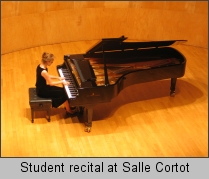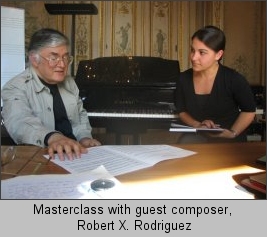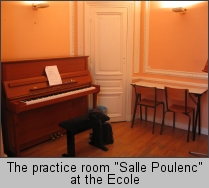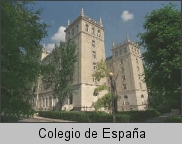REVIEW: The European American Music Alliance's program for composers
Originally published on ComposersOnline.org in October 2004.
Reprinted with permission.
The basics
 Beginning in 1996, the European American Musical Alliance has run a month-long summer composition program in Paris, France. Taught in English, it is said to be the only program for composers which carries on the legendary teaching tradition of Nadia Boulanger.
Beginning in 1996, the European American Musical Alliance has run a month-long summer composition program in Paris, France. Taught in English, it is said to be the only program for composers which carries on the legendary teaching tradition of Nadia Boulanger.
I attended the European American Musical Alliance (EAMA) program in July of 2001, and again from July 3-31, 2004. I just can't get enough of Paris, it seems, and now, after my second summer there, can confidently recommend that if you want an excuse to see Paris, don't apply for this program. But if you want a haven for serious study, do.
Indeed, Boulanger's philosophies truly permeate the entire program, most notably her work ethic. In the opening meeting, students are greeted with a full month's schedule of classes, masterclasses, private lessons, group fieldtrips, and concerts, with some days' schedules stretching from 9:30 AM through 10:00 PM. Each student's schedule allows for three hours of time in a practice room, which sometimes isn't enough to finish the coursework, and extends to late hours on the couches in the dorm, cracking lame jokes about invertible counterpoint and drinking cheap wine (which is, not surprisingly, quite good in France).
Dr. Philip Lasser, who has taught counterpoint, harmony, and analysis at Juilliard since 1994, and Narcis Bonet, former director of the American Conservatory of Fontainebleau (succeeding his mentor, Nadia Boulanger), co-run the program. I have a feeling, though, that a lot of behind-the-scenes work goes on by Pamela Lasser, who flits around tirelessly organizing and scheduling, all while keeping a close eye on her and Dr. Lasser's daughter, who is quite possibly the most darling two-year-old girl in the world. (And can I just say, her birthday party, which coincidentally fell during the program this year, was one of the funniest musical celebrations I have attended, with the professors "letting their hair down" by improvising piano variations on "Happy Birthday" in the style of any requested composer. You haven't heard musical satire until you've heard "Happy Birthday" played in the style of Webern by a disciple of Nadia Boulanger. I digress.)
The program for composers focuses heavily on the craft of composition, and prides itself on the fact that it is able to put "style" aside in order to focus on the application of the "tools" into each composition student's work. There are simultaneous programs offered in both piano and violin performance, but the academic classes are really dominated by composition students as the core of the EAMA program. While violin and piano students have more freedom in choosing electives, composition students are required to take Counterpoint, Harmony, Private Lessons, and either Ear Training or Score Reading. The classes in Analysis are more like workshops, with all students strongly encouraged to attend each weekly class. Also, in keeping with Boulanger's idea that music should be learned by playing and singing, participation in the Chorale is required for every student.
 As if that weren't enough, interspersed throughout the month, visiting professionals hold masterclasses and lectures, most of which are taught in English (or include translation). These visiting composers, violinists and pianists in 2004 included Robert X. Rodriguez, Bruce Brubaker, Frederic Chiu, and Emile Naoumoff. Also, a weekly two-hour Composition Forum is an opportunity for student composers to present and discuss their own music with each other.
As if that weren't enough, interspersed throughout the month, visiting professionals hold masterclasses and lectures, most of which are taught in English (or include translation). These visiting composers, violinists and pianists in 2004 included Robert X. Rodriguez, Bruce Brubaker, Frederic Chiu, and Emile Naoumoff. Also, a weekly two-hour Composition Forum is an opportunity for student composers to present and discuss their own music with each other.
The school
The first summer I attended the EAMA program, it took place at La Schola Cantorum in the Latin Quarter of Paris, just a few minutes away from the dorms by subway. Founded in 1895 by French composers Vincent d'Indy, Charles Bordes and Alexandre Guilmant to counteract the stifling atmosphere of the Paris Conservatory, La Schola is still drenched in history. Eric Satie, Darius Milhaud, Edgar Varèse, David Diamond, Olivier Messiaen, and Maurice Duruflé, all passed through its hallowed halls at one point as teachers or students. However, the facilities, now more than a bit run-down, do leave something to be desired. Many pianos are old, upright, and stuck in little outdoor non-soundproof cubicles which smell suspiciously like the Paris metro system. There is often a shortage of practice rooms (good ones, anyway), and the school is not all-enclosed, so rainy days can be very wet! The wetness, oldness, and smelliness does lend the place a certain unidentifiable charm, however. And with Luxembourg Gardens just down the street, a jazz club three doors down, and great Vietnamese food a few blocks away, the location is perfect.
 This summer, however, the program was held at L'Ecole Normale de Musique de Paris, which, contrary to the literature, is not exactly "at the heart of Paris." Though it is very close to Debussy's house and some of the best music stores in Paris, the Ecole is a 45-minute commute from the dorms by subway. The trade-off, however, is a lovely school with a classy concert hall. There are 26 practice rooms (with beautiful pianos, many of which are grands) all kept clean and dry, and some fun secret passageways to and from the concert hall into the school. A beautiful marble staircase climbs to the second floor (the "first" floor in France), and the climber rewarded all along her way by fine murals and paned windows. The lecture rooms have columns and fireplaces, gold-leaf wallpaper and chandeliers.
This summer, however, the program was held at L'Ecole Normale de Musique de Paris, which, contrary to the literature, is not exactly "at the heart of Paris." Though it is very close to Debussy's house and some of the best music stores in Paris, the Ecole is a 45-minute commute from the dorms by subway. The trade-off, however, is a lovely school with a classy concert hall. There are 26 practice rooms (with beautiful pianos, many of which are grands) all kept clean and dry, and some fun secret passageways to and from the concert hall into the school. A beautiful marble staircase climbs to the second floor (the "first" floor in France), and the climber rewarded all along her way by fine murals and paned windows. The lecture rooms have columns and fireplaces, gold-leaf wallpaper and chandeliers.
The students
Out of nearly 30 students who attended the program in 2004, there were a few obvious trends. The 10 or so pianists and violinists came from all over Europe and America, while the 20 composers were mostly from the USA, with one student each from Canada, China, and Japan. The age range is also worth mentioning. Two pianists in their mid-teens seemed to participate in some classes and concerts, but the core of students were either in undergraduate or post-graduate studies of some sort. The program accounts for different incoming abilities of students by offering four levels of Counterpoint and Harmony, and two levels of Ear Training and Score Reading, all based on placement tests taken just while you're recovering from jet-lag. (Beautiful.)
The teachers
There are seven instructors on staff, all of whom are well-versed in the philosophies of Nadia Boulanger, and some of whom actually studied with her. Each year there is also one visiting composer, who, this year, was Robert X. Rodriguez. Samuel Adler, David Diamond, and Lukas Foss have also been guests of EAMA.
 Mark Shapiro (director of Cantori New York and on the conducting faculty at Mannes College of Music) teaches Score Reading, Harmony, and conducts the Chorale. Mr. Shapiro's classes are a little
unnerving
There's no sitting in the corner and pretending you don't know the transposition of the clarinet, for instance. But as a teacher he is very thorough, giving much individual attention to students' academic needs, to the point of stopping us in the hallways asking what the range is of the English horn.
Mark Shapiro (director of Cantori New York and on the conducting faculty at Mannes College of Music) teaches Score Reading, Harmony, and conducts the Chorale. Mr. Shapiro's classes are a little
unnerving
There's no sitting in the corner and pretending you don't know the transposition of the clarinet, for instance. But as a teacher he is very thorough, giving much individual attention to students' academic needs, to the point of stopping us in the hallways asking what the range is of the English horn.
 As a composer, Maxim Vladimiroff has won honors, awards and publishing contracts. But it is particularly his skills as a pianist, I think, that bring him to this program. As one of EAMA's Harmony instructors, Mr. Vladimiroff is organized and thoughtful, and seems to embody all calmness and kindness. Like Bonet and Shapiro, he teaches from the Henri Challan book "380 Basses et Chants Donnes," and Bonet's book, "An introduction to keyboard harmony," which relies heavily on the basses and melodies of Paul Vidal.
As a composer, Maxim Vladimiroff has won honors, awards and publishing contracts. But it is particularly his skills as a pianist, I think, that bring him to this program. As one of EAMA's Harmony instructors, Mr. Vladimiroff is organized and thoughtful, and seems to embody all calmness and kindness. Like Bonet and Shapiro, he teaches from the Henri Challan book "380 Basses et Chants Donnes," and Bonet's book, "An introduction to keyboard harmony," which relies heavily on the basses and melodies of Paul Vidal.
 In his first analysis class, Philip Lasser proclaims that there are two critical errors in music notation: it's flat, and it's linear. Using Bach's Invention #4, he lectures on the effectiveness of layering in music, using his skilled piano technique to "paint" each layer a different color, showing exactly how each contrapuntal voice is moving. Indeed, this type of contrapuntal layering plays a crucial role in Lasser's musical thought, emerging time and again in his Counterpoint and Harmony classes, lessons, and workshops.
In his first analysis class, Philip Lasser proclaims that there are two critical errors in music notation: it's flat, and it's linear. Using Bach's Invention #4, he lectures on the effectiveness of layering in music, using his skilled piano technique to "paint" each layer a different color, showing exactly how each contrapuntal voice is moving. Indeed, this type of contrapuntal layering plays a crucial role in Lasser's musical thought, emerging time and again in his Counterpoint and Harmony classes, lessons, and workshops.
Lasser is a fine composition teacher whose analysis of student work is not only careful and detailed, but seems always governed by the music's emotional impact, or what he calls "the Wiltingly Beautiful." In the four weeks of his counterpoint class, I often heard him say, "Why, this is beautiful! It breaks every rule in the book, but it's beautifully done. Let's all sing this example " At my last lesson with Dr. Lasser, after asking him how I might best continue my study after the EAMA program, he pointed to my copy of Bach's Well-Tempered Clavier and said, "Play these every day. Play. And sing. And cry." In both his private lessons and his counterpoint classes, his criticism is well thought-out and tailored to fit each student's individual needs, often drawing on his extensive knowledge of the musical cannon to recommend listening and specific study.
Unfortunately, with the program drawing greater numbers of composers each year, Lasser, has less time to spend socializing with his students outside of class, but smokers are in luck, as they will be sure to find him between classes in the foyer. He is also the reigning champion of the Official EAMA Foosball Tournament, a practically required event involving lots of wine and an old, mildly askew foosball table.
 Though constantly chastising students for writing premature perfect cadences (asserting that "Ah, zee perfect cadence, zat eez zee music of dying!") Narcis Bonet is a man of all-compassion, of kind, twinkling eyes, and of great enthusiasm for life. He seems, to me, to be able to relate to any of the various styles of music students put before him, using much metaphor to describe in "scientific" terms what it means to translate into music our experience of being alive. He particularly advocates creating well-wrought tension in music through the tools of Duration, Intensity and Rhythm, saying "Never expect to boil zee water wissout turning on zee gas!" He also enjoys waxing poetic on the specific choices of enharmonics (not a short lecture), the hierarchy of the tonal system as if it were a parliament, and voice-leading like choosing a designated driver ("Ah oui, zee alto, she is a good and sober driver, no?").
Though constantly chastising students for writing premature perfect cadences (asserting that "Ah, zee perfect cadence, zat eez zee music of dying!") Narcis Bonet is a man of all-compassion, of kind, twinkling eyes, and of great enthusiasm for life. He seems, to me, to be able to relate to any of the various styles of music students put before him, using much metaphor to describe in "scientific" terms what it means to translate into music our experience of being alive. He particularly advocates creating well-wrought tension in music through the tools of Duration, Intensity and Rhythm, saying "Never expect to boil zee water wissout turning on zee gas!" He also enjoys waxing poetic on the specific choices of enharmonics (not a short lecture), the hierarchy of the tonal system as if it were a parliament, and voice-leading like choosing a designated driver ("Ah oui, zee alto, she is a good and sober driver, no?").
 A popular composition teacher among the students writing in a less-traditional vein at the EAMA program, Michel Merlet keeps a low profile at the program, possibly due to his dual teaching responsibilities at the Paris Conservatory and the École Normale de Musique de Paris. Back in the day, he won the Prix de Rome, and many of the hard-to-please students in the program this year were impressed with his music featured on the EAMA concerts throughout the month. With all the traditional emphasis of the EAMA program, I found his sound refreshing and surprising, with enough tonality to keep my interest and plenty of musical risks keep my curiosity piqued.
A popular composition teacher among the students writing in a less-traditional vein at the EAMA program, Michel Merlet keeps a low profile at the program, possibly due to his dual teaching responsibilities at the Paris Conservatory and the École Normale de Musique de Paris. Back in the day, he won the Prix de Rome, and many of the hard-to-please students in the program this year were impressed with his music featured on the EAMA concerts throughout the month. With all the traditional emphasis of the EAMA program, I found his sound refreshing and surprising, with enough tonality to keep my interest and plenty of musical risks keep my curiosity piqued.
Robert X. Rodriguez (guest composer)
 In his three days at the 2004 EAMA program, Robert X. Rodriguez, composer at the University of Texas at Dallas, enlightened participating students with two activities: one lecture on his own music, which includes symphonies, chamber music, and opera, and one masterclass on the music of five randomly-chosen students from the program. I found Dr. Rodriguez (or "X-Rod," as a handful of students fondly referred to him) to be highly quotable, and enjoyed memorizing many of his statements, including, "There are two things in this life that always work: A woman's tears, and brass in octaves," and "Promotion is like sex
you can never get enough."
In his three days at the 2004 EAMA program, Robert X. Rodriguez, composer at the University of Texas at Dallas, enlightened participating students with two activities: one lecture on his own music, which includes symphonies, chamber music, and opera, and one masterclass on the music of five randomly-chosen students from the program. I found Dr. Rodriguez (or "X-Rod," as a handful of students fondly referred to him) to be highly quotable, and enjoyed memorizing many of his statements, including, "There are two things in this life that always work: A woman's tears, and brass in octaves," and "Promotion is like sex
you can never get enough."
Because of EAMA's allegiance to the teachings of Nadia Boulanger, Rodriguez's critique of student works was largely influenced by what "Mademoiselle" might have said. Like Lasser, Rodriguez asserts that Boulanger's secret to successful teaching was encouraging young composers to find their own voices. "This was Nadia's most mystical idea, and her greatest gift as a teacher," he said. Still, such a fond sentiment didn't prevent Rodriguez from telling students how he really felt about their music. After hearing an excerpt of an opera by Amherst graduate James Orsher, Rodriguez looked intently at Orsher, then said slowly, "You're lucky you haven't been locked up. You are a certifiably crazy person."
If you go
 EAMA gives students the option of living in one of two dorms in the Cite Universitaire: the Colegio d'Espana (founded for Spanish students), or the Fondation des Etats-Unis (founded for American students). You want to live in the Colegio, even though you may not understand a thing anyone says to you all month. The Colegio provides breakfast, cleans your room once a week, and has a computer lab (PCs with Finale and free internet access), laundry, a small weight room, multiple grand pianos (although access to them is literally under lock and key), and two practice rooms. The Fondation, on the other hand, basically has a foosball table and a small organ in the basement. And if you really want to play that organ, there are ways to get in anyway.
EAMA gives students the option of living in one of two dorms in the Cite Universitaire: the Colegio d'Espana (founded for Spanish students), or the Fondation des Etats-Unis (founded for American students). You want to live in the Colegio, even though you may not understand a thing anyone says to you all month. The Colegio provides breakfast, cleans your room once a week, and has a computer lab (PCs with Finale and free internet access), laundry, a small weight room, multiple grand pianos (although access to them is literally under lock and key), and two practice rooms. The Fondation, on the other hand, basically has a foosball table and a small organ in the basement. And if you really want to play that organ, there are ways to get in anyway.
It's hard to live cheaply in Paris. It's just plain hard. But there are kitchens in the Colegio which include little refrigerated lockers and private cabinets for food storage (both open with your room key - what a wonderful idea!), so making your own meals is really very easy. Besides the obvious benefit of avoiding the mysterious and sometimes frightening French cuisine (a slab of pink "boeuf" with a raw "oeuf" on top? People eat that?), being in the dorm kitchen is a great way to meet people. Only about 12 of the hundred or so students living in the Colegio are from the EAMA program, so it's very easy to meet new people, most of whom are of an arty nature. Chances are, you'll meet a hot Spanish philosopher who can speak 5 languages fluently and want to make you tapas and feed it to you while discussing Hegel. Or, perhaps, you'll befriend a tall German man who suddenly decides to return to Bonn, leaving you ALL HIS FOOD! (Thank you, Nic, wherever you are )
In short
The EAMA summer program in composition will afford you very little time to see Paris. It is intensely scheduled, well-organized, and with such a high student-teacher ratio that you feel positively guilty skipping class. (Besides, with tuition at $3,100, you'll want to get your money's worth! Scholarships are available, however.) Their website is right when it says it is a "haven for serious study." I grew more musically in a month than I could have imagined, wrote some music I like, met lifelong friends, and formed solid professional relationships with my professors. But I still haven't seen the Louvre.
More on the EAMA Summer Program in Composition can be found at www.eamusic.org.
- - - - - - - - -There are a few things I wish I'd known sooner:
- To take the metro from the airport to the Cite U. Not a taxi. No matter how tired you are.- Enough words to ask for the key to the private music composition lab at the Colegio.
- Don't even think about sleeping in the foyer of the Ecole, or be ready to wake up to an earful of angry French.
- Grocery stores close at very weird times (Sunday all day?). Don't count on them to be open after class.
- To buy a plane ticket that allows a few more days after the program to travel with new friends.
- There's a secret window into the weight room at the Colegio, through which you can watch many Spanish men lifting heavy objects.
- - - - - - -
I wish I had brought:
1) warm clothes, raincoat2) more than one CD of my own music
3) original pieces for piano and violin
4) band-aids for sore feet
5) a French dictionary that doesn't look so obvious
I wish I hadn't brought:
1) tennis shoes2) shorts (too American!)
3) the wrong electric current adaptor
4) the Beethoven piano sonatas
5) any full orchestral scores
- - - - - - -
Links:
EAMA: http://www.eamusic.orgCite Universitaire: http://www.ciup.fr
Colegio d'Espana http://www.colesp.net
Fondation des Etats-Unis http://www.anglais.ciup.org/citeaz/maisons/usa/index.html
Ecole Normale de Musique http://ecolenormalecortot.com
